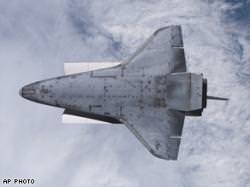As it was approaching the International Space Station, the space shuttle Endeavour performed a back flip maneuver to expose its underside to the station residents. The astronauts captured high-resolution images of the shuttle’s underbelly, and uploaded them to NASA analysts to see how the shuttle fared during takeoff. Not well, apparently.
NASA engineers back on Earth are studying a gouge made in the shuttle’s protective tile system by a chunk of foam that fell during launch. The gouge was carefully measured by a laser and camera system attached to the shuttle’s robotic arm. The gash runs all the way through a tile on the underside of Endeavour, exposing bare metal. Engineers will perform a series of heat tests to understand the thermal properties of the damage. Tiles with a physical mockup of the damage will be exposed to similar conditions that Endeavour will face during reentry to understand the risks involved.
Once they understand the extent of the damage, and the potential risk to the shuttle, NASA will make a decision if and how the astronauts will repair the damage. They have three options: paint the section, screw in a protective plate, or fill the hole with a special protective goo.
Now, onto the actual mission. Their first spacewalk was on Saturday, August 11th. Rick Mastracchio and Dave Williams stepped outside to install the new starboard truss segment to the end of the International Space Station. Their entire trip outside lasted 6 hours and 17 minutes, and was hassle free, except for a computer shutdown in NASA’s Destiny laboratory. This forced backup computers to take over the operations of the module, but had no impact on the spacewalk.
The second spacewalk begins on Monday. This time, Mastracchio and Williams will step outside the station again, but this time to replace a broken gyroscope that the station uses to keep itself oriented. This spacewalk will also last approximately 6.5 hours. While the station can maintain its orientation with just two gyroscopes, it’s preferable to have all 4 working, to help spread the load of all the additional modules being added.
Source:NASA Status Report

